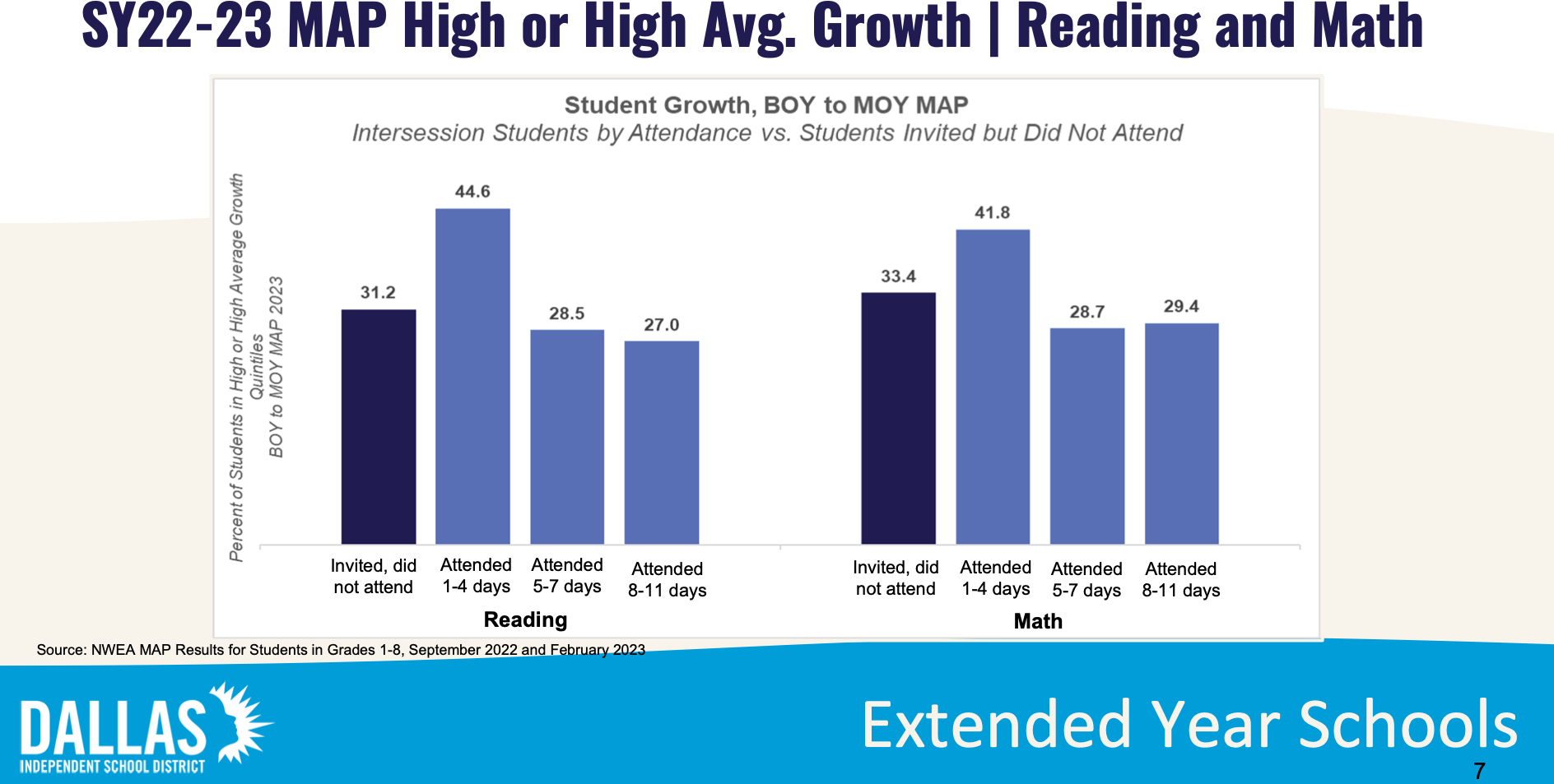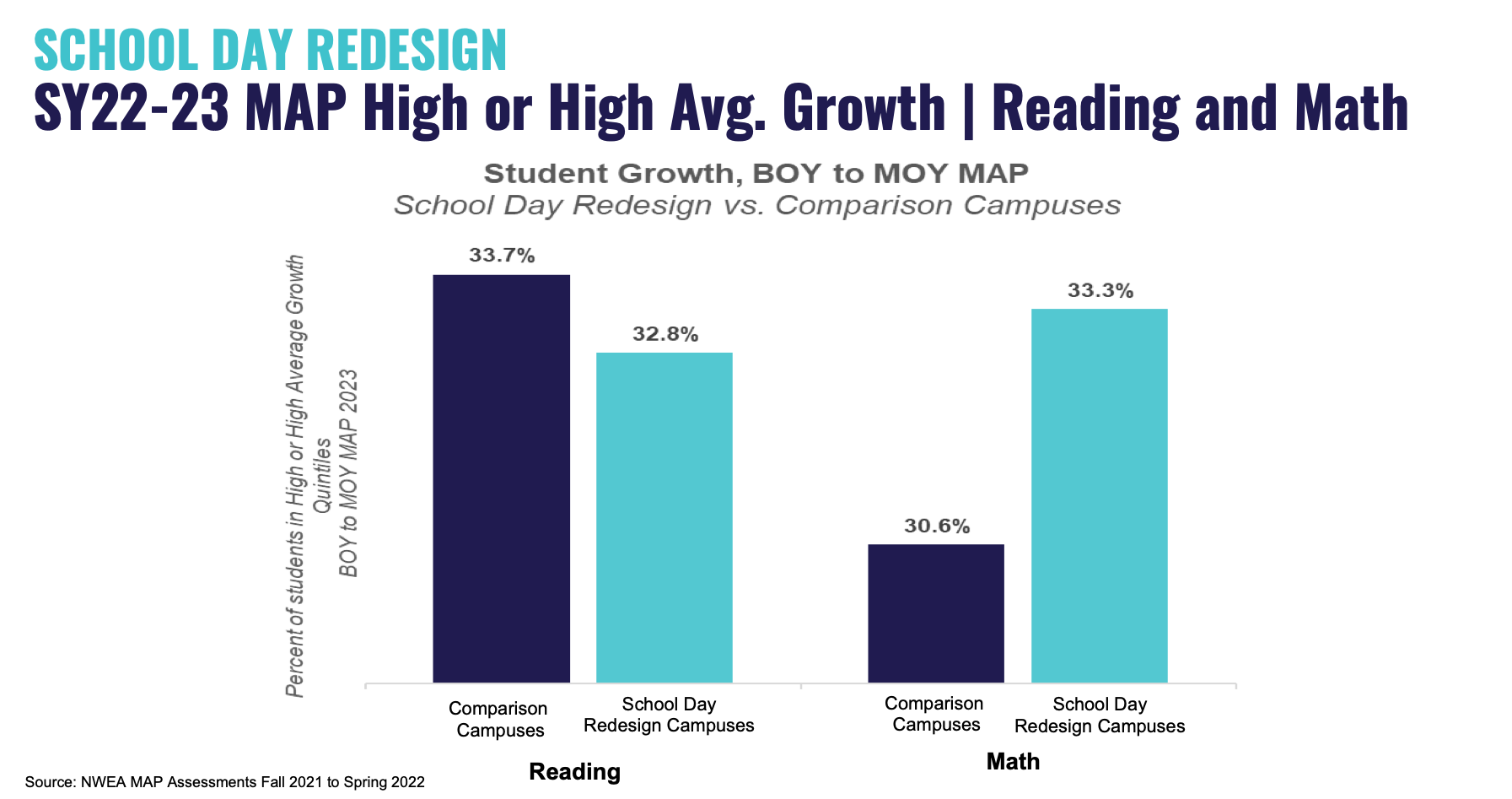When students returned to school in 2021 after months of virtual learning during the pandemic, Dallas ISD knew it would need to address learning gaps.
One of its experiments involved introducing two calendars that extended the school year for campuses that opted in. The goal was to provide more time for teachers to get kids back up to speed.
Now two years later, the district is examining whether test scores prove a longer school year improved student outcomes. At the Dallas ISD board of trustees briefing last week, Chief Academic Officer Shannon Trejo walked the board through some preliminary data that indicates that offering three potential calendars—a standard calendar, an intersession calendar, and a school-day redesign calendar—may have helped some students retain more of what they learned.However, the gains were less than what trustees expected.
The 175-day base calendar is still used by 194 schools within the district. But as of last year, campuses could also opt for an intersession calendar that added 21 additional days of instruction, which were optional. They also could choose a school day redesign calendar that added up to 28 extra days that were not optional. Forty-one schools opted in to the intersession calendar. Five schools chose the school day redesign.
The verdict? Extending the school year did lead to some growth. The district measured that growth two ways: the Measures of Academic Progress (or MAP) test, which is given at the beginning, middle, and end of the year, and the STAAR test results.
Let’s begin with STAAR results. Kids who met state standards in reading and attended schools on a standard calendar dropped by about 5.5 points during the pandemic. Those same campuses improved by about 9 points last year.
Intersession schools saw a pandemic drop of 8 points, but improved by almost 10 points last year. School day redesign campuses had a drop of 6.1 points, but rebounded last year by 12.5 points.
In math, standard calendar schools saw smaller gains last year, but also had less ground to make up than intersession and school day redesign campuses.
What was missing from this presentation, though, was the results among students who are on the cusp of meeting the state standard in these subjects. Trejo said the team chose to share only the data from the students that had already met or exceeded where the state expects them to be.
Seeing the growth pattern among students who are nearly meeting the state standard is equally important in providing context. If there was a huge increase of students in that group versus the group that failed to meet state standard, for instance, that’s also an indicator of the kind of growth the district would like to see from a more widely used program.
While students in extended school year campuses generally showed more growth, their scores were still about equal to the students attending campuses with a standard calendar.
MAP testing scores provide more detail on a granular level. Last year, even students who attended fewer than six intersession days showed greater growth in reading from the beginning of the year to the end of the year. In math, the gain was negligible for kids who showed up for between zero and six extra days, but the improvement was higher for students who attended seven or more additional days.
Trejo also compared the scores of students who attended intersession to those who had been flagged for needing the additional support but did not attend additional school days.
Students who attended even one to four days of intersession this year have seen big gains compared to students who were invited to attend but did not—44.6 compared to 31.2 percent in reading scores, and 41.8 compared to 33.4 in math.
Trejo was quick to point out that the board was looking at just the first few months of school, and end of year data would paint a more full picture.
School day redesign campuses saw an 8.7 point gain in reading scores, and an almost 6 point gain in math scores last year. This year, those campuses are seeing their biggest gains in math so far.
The district is now meeting with the campuses that adopted the extended school year calendars. The two-year plan is almost up, and district officials and principals will discuss whether they’d like to continue.
But more importantly, Trejo said the district would also be looking at other interventions it uses to help students during those extra days.
“The research on extended time in school states that it’s not necessarily more time as much as what you do with that time,” she said. “We can extend the calendar, but we want to make sure that what we’re doing with the extra time is making a difference for students.”
The board questioned whether the results merited continued investment, given that the Texas Legislature could modify funding mechanisms this session and federal pandemic relief funds are drying up.
“I think it’s awesome that we tried this,” trustee Dustin Marshall said. “I was a supporter of this two years ago when we were having this conversation because it seemed intuitive to me … but the data on this didn’t tell the story that I think many of us thought it would tell.”
Elizalde said it may be too soon to tell if the program is effective because of how fatigued teachers were during its implementation.
“I think some of the mixed data comes from the fact that we heard overwhelmingly from our teachers how tired they were,” she said. “The design was that more time should create better student outcomes. I think we have to ask ourselves, ‘Did we provide them the time?’
“There’s also the argument that one more year might get us a totally different set of data and we have a limited budget, so we have to make decisions based on the information that we do have,” she added.
There is room for improvement and inflection, including examining the data to see if this idea is one of the ones that Elizalde said last summer might end up being jettisoned.
“The way I like to address this is with what I do know absolutely was probably not very much value. That’s easier to say than what definitely worked,” she said in July. “I’m going to be asking about what we think did not have too much of an impact, rather than what we think had the most impact.”
Get the D Brief Newsletter
Author







